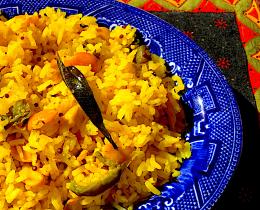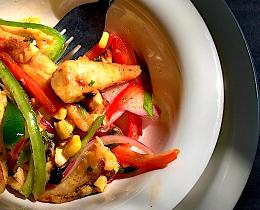If you are one of the thousands of people who visit Omega’s Rhinebeck campus each year, then you know about the magic that happens at the dining hall. During our busy season, we create three delicious local, mostly organic, sustainable, nutrient-dense meals that offer an array of options to help meet the dietary needs of our participants.
One of the most common remarks overheard at the dining hall is, “I wish I could eat like this at home!”
With a little preparation, you can.
Here are three strategies to set you up for making your own delicious meals.
1) Shop Local
Great meals start with good ingredients, so that means shopping for fresh, healthy produce. At Omega we source many of our foods from local farms and vendors.
To find the freshest ingredients for your kitchen, locate your local farmers market and support local farmers who are growing food in a sustainable way. It doesn't get any fresher than that! Shopping at the farmers' market also helps you to eat with the seasons.
If you don't have a farmers market nearby you can still get fresh produce at your local grocery store. You may even find your local store carries local fruits or vegetables when they're in season.
2) Prep Weekly
The Omega kitchen would never be able to serve so many people without planning. At home, one of the best ways you can eat better is to plan ahead. Set aside as little as 30 minutes on Sunday to create a strategy for the week. Pick a few recipes, survey your pantry for ingredients, and begin prep. Think of this extra time in the kitchen as an investment in your health—and prepare to be surprised at how smoothly your week will go when you have food ready to eat.
In about 30 minutes, you can:
- Chop veggies so they are easier to snack on with hummus or guacamole
- Roast veggies like cauliflower, broccoli, sweet potatoes, or zucchini
- Boil eggs for quick snacks
- Make a pot (or two) of grains for the week
- Soak beans to be cooked later in the week
As you plan meals, think about how you can cook once but eat many times. For instance, you can make a double batch of rice and use it in two dishes—maybe as a fried rice and a rice salad. You can also make a big pot of soup or stew and freeze some of it for future use.
Some meals can be made ahead of time, like overnight oats, or you can make a large meal (like a vegetarian shepherd's pie, vegan chili, or wheat berry salad) and portion it out into single-serve containers for easy, to-go lunches or quick dinners on a busy night.
3) Make Over Your Pantry
To get the most out of your weekly prep time, you'll want to have the right ingredients on hand and that often requires a pantry makeover. Toss or compost foods that don’t make you feel good or have been sitting on the shelf for years. Remove processed foods completely or replace them with a higher quality version. Are your canned black beans organic? Do your crackers have a long list of ingredients? Some convenience foods are better than others—a general rule of thumb is the fewer the number of ingredients on the list, the better.
You don’t have to break the bank when adding new options to your shelves. Consider adding one new item to your pantry each week and allow some transition time to get fully stocked. By keeping your kitchen full of wholesome ingredients, you’re much more likely to eat well.
It's helpful to have some fresh food on hand, too. In the spring and summer stock your fridge with smoothie and salad ingredients, like fresh berries, greens, avocados, vegetables, and fruit. During cooler months, be sure you have staples for making soup, stews, and breakfast porridge with ingredients like onions, garlic, winter squash, sweet potatoes, canned or dry beans, and frozen vegetables and berries.
Here's a shopping list to get you started:
General Pantry Essentials
- Olive oil, coconut oil, or ghee
- Apple cider vinegar, rice vinegar, or balsamic vinegar
- Hot sauce
- Nut or seed butters
- Fruit preserves
- Maple syrup, honey, or stevia
- Raw nuts (almonds, cashews, or pecans)
- Seeds (sunflower, pumpkin, or chia)
- Organic teas and coffee
Grains
- Brown or white rice
- Whole rolled or steel cut oats
- Rice noodles
- Quinoa
- Millet
- Bulgur
Legumes
- Black beans
- Chickpeas
- Red beans (kidney, adzuki, or pinto)
- White beans
- Lentils
- Mung beans
- Tofu or tempeh
Spices & Seasoning
- Sea salt
- Gomasio (a mixture of sea salt and sesame seeds)
- Black pepper
- Chili powder
- Curry powder
- Cinnamon
- Ginger
- Nutritional yeast
- Tamari (soy sauce)
Counter produce (no need to refrigerate)
- Apples
- Avocados
- Bananas
- Garlic
- Onions
- Tomatoes
- Potatoes
- Sweet potatoes
- Winter Squash (butternut, acorn, or pumpkin)
Refrigerator Items
- Salad greens
- Carrots
- Cucumber
- Broccoli or cauliflower
- Dark leafy greens (kale or collard greens)
- Mushrooms
- Spinach
- Sprouts
- Zucchini or summer squash
- Eggs (if you eat them)
- Dairy or nut milk
- Yogurt/vegan yogurt
- Butter/vegan butter
Treats
- Dark chocolate
- Rice crackers or rice cakes
- Sourdough or gluten-free bread
- Granola
- Olives
- Cheese
- Hummus



